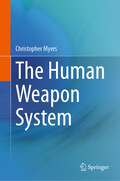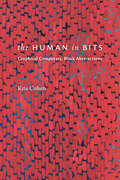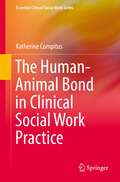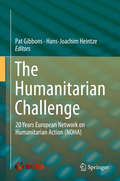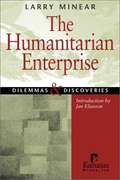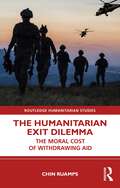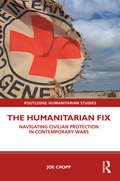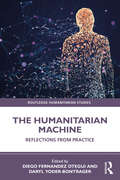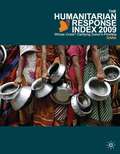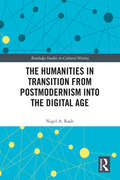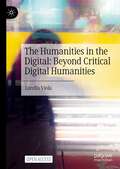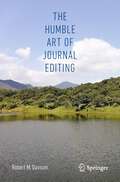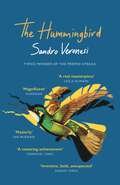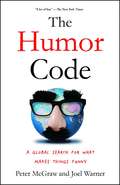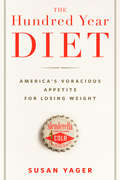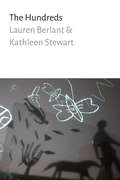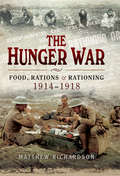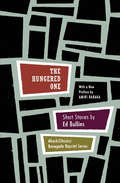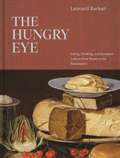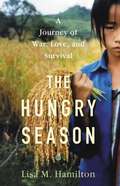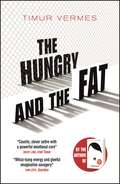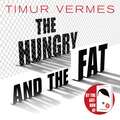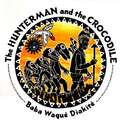- Table View
- List View
The Human Weapon System
by Christopher MyersThis book discusses the differences between a human weapon system and a tactical athlete and what a human optimization program is. Furthermore, this book discusses and demonstrates how to put together a training program at an organizational level for the human weapon system. A systematic approach is presented and discussed, from initial analysis of the human weapon system to creating a multi-domain human performance optimization program. This book strives to familiarize the reader with the systematic approach that the author has utilized as an exercise physiologist in the Department of Defence over the past ten years. This book also explains how to utilize technology to individualize the human performance optimization program at an organizational level. The book discusses current technologies in power generation, measuring endurance, and nutrition, and also demonstrates to strength coaches and practitioners how to use these technologies and individualize optimization.
The Human in Bits: Graphical Computers, Black Abstractions
by Kris CohenIn The Human in Bits, Kris Cohen examines black abstractionist painting to demonstrate how race and computation are intimately entangled with the personal computer’s graphic user interface. He shows how the personal computer and the graphical field of its screen meant to transform the human by transforming what environments humans were to labor in. It also provided the means for whiteness to tie itself to notions of colorblind meritocracy. Cohen focuses on the post-1960s experiments of black abstractionists Alma Thomas, Jack Whitten, Charles Gaines, and Julie Mehretu, who developed a nonrepresentational approach to blackness that was oriented more toward constraint than human expression. From Gaines’s use of grids to Mehretu’s layering of paint, these artists—in their knowledge that black life had always been conflated with numbers and bits of information—flirted with repetition, systems, and formulas to test other ways of being human. By demonstrating how these artists bypassed the white fear that the human would become interchangeable with data, Cohen reframes modernism and modernist art to account for racialization in computational cultures.
The Human-Animal Bond in Clinical Social Work Practice (Essential Clinical Social Work Series)
by Katherine CompitusThe human-animal bond may be described as a dynamic, mutually beneficial relationship between people and the animals they care for. There are a multitude of mental and physical health benefits for people who care for animals, and animals in therapy have been shown to aid a wide range of people and illnesses. Although the benefits of animal companionship have long been suspected, little is known about the research, the process, or why it works. This book provides clinicians with a history of the human-animal bond and the rationale for incorporating animals into therapy today.In this book, the author includes a discussion of the myriad of ways that clinicians can directly help people care for their pets, such as crisis intervention services, policy issues, grief counseling for pet loss, and compassion fatigue in the veterinary profession. There also is a thorough discussion of animal-assisted therapy (AAT) as a distinct and unique modality. The adaptive nature of AAT is not only due to the symbiotic relationship between humans and animals, but also because of the flexible nature of the model; it can be used with clients of all demographics and with most mental illnesses. Research shows that the majority of mental health practitioners believe that AAT is a valid treatment modality, but AAT has not yet been manualized and clinicians are left confused about where to start. The Human-Animal Bond in Clinical Social Work Practice is a unique and essential resource that provides guidelines for developing AAT treatment plans and integrating AAT with existing therapeutic models. The book answers the questions that social workers, psychologists, psychiatrists, and other mental health counselors may have about the benefits of the human-animal bond and ways to tap into that special bond in direct practice.
The Humanitarian Challenge
by Hans-Joachim Heintze Pat GibbonsThis book includes contributions from academics, practitioners and policy-makers connected with the Network on Humanitarian Action (NOHA), an international association of universities that is committed to interdisciplinary education and research on humanitarian action. Celebrating the twentieth anniversary of NOHA, this book highlights some of the most pressing issues and challenges facing humanitarian action and explores potential solutions. Drawing on theory and practice, and spanning a broad range of subject matter, the book explores the origin of key concepts such as human security, reconciliation and resilience and questions their effectiveness in the pursuit of humanitarian ends. It also charts current developments in the humanitarian system, in particular in its legal and financial frameworks. Issues relating to humanitarian stakeholders, such as the role of the media and the protection of humanitarian workers, are also addressed. The contributions are influenced by a range of disciplines, including anthropology, political science, legal studies and communications.
The Humanitarian Enterprise: Dilemmas and Discoveries
by Larry Minear John Hammock Jan EliassonInternational humanitarian activities have grown enormously in scale over the past ten years. A longside this greater experience, the complex links between humanitarian work and the worlds of politics and military engagement have become ever more contested. Through the lens of the Humanitarianism and War Project, Larry Minear explores what international humanitarians - from the UN and national governments, to the Red Cross and the many private relief and development agencies - have learned about how to do humanitarian work well, and the arguments which remain unresolved. With an epilogue on the issues highlighted by the international response to the terrorist attacks of 2001 and the war in Afghanistan, this book will be of interest to anyone wishing to understand the future of humanitarianism in the twenty-first century.
The Humanitarian Exit Dilemma: The Moral Cost of Withdrawing Aid (Routledge Humanitarian Studies)
by Chin RuampsHow should humanitarian organisations respond when their aid goes awry? Should they stay and remain engaged with the needy, or should they withdraw and leave? Investigating the choices involved and the judgements required when tackling these questions, this book explores the unique ‘Humanitarian Exit Dilemma’ that confronts humanitarian organisations. Humanitarian practitioners often are too concerned with the outcome of action but fail to recognise that there are other equally weighty moral considerations they should consider. Focusing simply on the results of projects, such as the number of lives saved alone, is inadequate. To address this problem, this book highlights three value-based normative considerations, namely humanitarian aid workers’ special relationships with those whom they are assisting, humanitarian organisations’ causal responsibility to assist those they have made vulnerable, and humanitarian organisations’ obligations to fulfil reasonable expectations of those assisted. Together, these three non-instrumental reasonings serve as the main arguments of the author's value-based normative account, the ‘Non-Consequentialist Approach’, to address the Humanitarian Exit Dilemma. Offering a unique perspective on how humanitarian organisations should navigate the Humanitarian Exit Dilemma, this book will be of interest to scholars and practitioners in the field of Humanitarian Studies, African Studies, Refugee Studies, political philosophy, humanitarian action, and human rights.
The Humanitarian Fix: Navigating Civilian Protection in Contemporary Wars (Routledge Humanitarian Studies)
by Joe CroppThis book investigates how humanitarians balance the laws and principles of civilian protection with the realities of contemporary warzones, where non-state armed actors assert cultural, political and religious traditions that are often at odds with official frameworks. This book argues that humanitarian protection on the ground is driven not by official frameworks in the traditional sense, but by the relationships between the complex mix of actors involved in contemporary wars. The frameworks, in turn, act as a unifying narrative that preserves these relationships. As humanitarian practitioners navigate this complex space, they act as unofficial brokers, translating the official frameworks to align with the often-divergent agendas of non-state armed actors. In doing so, they provide an unofficial humanitarian fix for the challenges inherent in applying the official frameworks in contemporary wars. Drawing on rich ethnographic observations from the author’s time in northern Iraq, and complemented by interviews with a range of fieldworkers and humanitarian policy makers and lawyers, this book will be a compelling read for researchers and students within humanitarian and development studies, and to practitioners and policy makers who are grappling with the contradictions this book explores.
The Humanitarian Machine: Reflections from Practice (Routledge Humanitarian Studies)
by Diego Fernandez OteguiAs the world reels from the impact of a global pandemic and increasing intensity of climate-caused hazards, the humanitarian sector has never been more relevant. But providing aid to those affected by disasters and crises is more complex than ever. In The Humanitarian Machine aid workers reflect on their own experiences of working in crisis. As they write about their work and the ways in which they each approach the challenges of helping people, they comment on some of the most vexing issues facing the humanitarian sector. Each speaks from their own perspective, asking tough questions, sharing thoughtful reflections about their ongoing work, and unpacking what it really means to be a humanitarian worker. The stories they tell, whether recounting a specific experience or reflecting on years of practice, reveal the dilemmas they face and demystify the overly romanticized aura that sometimes surrounds humanitarian practice. Complementing the candid accounts that humanitarian leaders contribute in this book, the editors examine how their stories, perceptions, and understandings align with similar conversations that take place in other settings. Viewed together in this way, the insights and reflections provided in this book will be invaluable for humanitarian practitioners, students, and researchers alike.
The Humanitarian Response Index 2009
by DaraOver 350 million people are affected each year by disaster and conflict. The international community is often unable to respond effectively to these crises. This report provides an independent examination of donor performance with the aim of improving the effectiveness of aid, and promoting greater accountability of donors.
The Humanities in Transition from Postmodernism into the Digital Age (Routledge Studies in Cultural History #89)
by Nigel A. RaabThe Humanities in Transition explores how the basic components of the digital age will have an impact on the most trusted theories of humanists. Over the past two generations, humanists have come to take basic postmodern theories for granted whether on language, knowledge or time. Yet Michel Foucault, Jacques Derrida and similar philosophers developed their ideas when the impact of this digital world could barely be imagined. The digital world, built on algorithms and massive amounts of data, operates on radically different principles. This volume analyzes these differences, demonstrating where an aging postmodernism cannot keep pace with today’s technologies. The book first introduces the major influence postmodern had on global thought before turning to algorithms, digital space, digital time, data visuals and the concept to digital forgeries. By taking a closer look at these themes, it establishes a platform to create more robust humanist theories for the third millennium. This book will appeal to graduate students and established scholars in the Digital Humanities who are looking for diverse and energetic theoretical approaches that can truly come to terms with the digital world.
The Humanities in the Digital: Beyond Critical Digital Humanities
by Lorella ViolaThis open access book challenges the contemporary relevance of the current model of knowledge production. It argues that the full digitisation of society sharply accelerated by the COVID-19 pandemic has added extreme complexity to the world, conclusively exposing the inadequacy of our current model of knowledge creation. Addressing many of the different ways in which reality has been transformed by technology – the pervasive adoption of big data, the fetishisation of algorithms and automation, and the digitalisation of education and research – Viola examines how the rigid conceptualisation in disciplines’ division and competition is complicit of promoting a narrative which has paired computational methods with exactness and neutrality whilst stigmatising consciousness and criticality as carriers of biases and inequality. Taking the humanities as a focal point, the author retraces schisms in the field between the humanities, the digital humanities and critical digital humanities; these are embedded, she argues, within old dichotomies: sciences vs humanities, digital vs non-digital and authentic vs non-authentic. Through the analysis of personal use cases and exploring a variety of applied contexts such as digital heritage practices, digital linguistic injustice, critical digital literacy and critical digital visualisation, the book shows a third way: knowledge creation in the digital.
The Humble Art of Journal Editing
by Robert M. DavisonThe publication of scholarly research is both a major driver of social progress and a significant industry in its own right. Scholarly research is the focus of attention for countless numbers of scholars globally and a key measure of scholarly excellence. Much has been written about the conduct of research that is designed to help scholars attain appropriate standards of rigor and relevance, and indeed craft their research outputs in ways appropriate for different venues, notably as journal articles, conference papers, book chapters, and books. However, although scholarly researchers fulfill roles other than as authors, for instance as journal reviewers and editors, there is a dearth of consolidated information about the nature of editorial work. Drawing on over two decades of experience in editing scholarly journals, the author offers a more systematic guide to scholarly journal editing.The book begins with an introduction to the art of scholarly journal editing,the nature of that art (Chapter 1), and an examination of editorial promulgation of cultural values of scholarly journals with an emphasis on responsible research (Chapter 2). Chapter 3 examines the many issues associated with sourcing content, and opines on the novelty, breadth, and depth of research, including discussions of indigenous theorization, serendipity, iconoclastic research, and the value of special issues. Chapter 4 deals with the review process and offers advice for formulating effective reviewer guidelines that lead to constructive and developmental advice for authors. The next two chapters discuss the audience of the journal as well as publisher relations. Finally, the book is concluded with thoughts and recommendations about emerging challenges, such as the ethics of AI tools (like ChatGPT), predatory journals, and the open-access movement.Offering a practical guide to editing scholarly journals, this book will be a key resource for scholars making the leap from researcher to editor, regardless of discipline.
The Hummingbird: ‘Magnificent’ (Guardian)
by Sandro VeronesiA BOOK OF THE YEAR FOR THE GUARDIAN: 'DEEPLY PLEASURABLE'A BOOK OF THE YEAR FOR THE SPECTATOR: 'WHAT A JOY''Magnificent' Guardian'A towering achivement' Financial Times'Inventive, bold, unexpected' Sunday Times'Everything that makes the novel worthwhile and engaging is here: warmth, wit, intelligence, love, death, high seriousness, low comedy, philosophy, subtle personal relationships and the complex interior life of human beings'Guardian'Not since William Boyd's Any Human Heart has a novel captured the feast and famine nature of a single life with such invention and tenderness'Financial Times'There is a pleasing sense of having grappled with the real stuff of life: loss, grief, love, desire, pain, uncertainty, confusion, joy, despair - all while having fun'The Sunday Times'Instantly immersive, playfully inventive, effortlessly wise'Observer'Masterly: a cabinet of curiosities and delights, packed with small wonders'Ian McEwan'A real masterpiece. A funny, touching, profound book that made me cry like a little girl on the last page'Leïla Slimani'A remarkable accomplishment, a true gift to the world'Michael Cunningham'Ardent, gripping, and inventive to the core'Jhumpa LahiriMarco Carrera is 'the hummingbird,' a man with the almost supernatural ability to stay still as the world around him continues to change.As he navigates the challenges of life - confronting the death of his sister and the absence of his brother; taking care of his parents as they approach the end of their lives; raising his granddaughter when her mother, Marco's own child, can no longer be there for her; coming to terms with his love for the enigmatic Luisa - Marco Carrera comes to represent the quiet heroism that pervades so much of our everyday existence.A thrilling novel about the need to look to the future with hope and live with intensity to the very end.THE NO. 1 INTERNATIONAL BESTSELLEROver 300,000 copies soldSoon to be a major motion pictureWinner of the Premio StregaWinner of the Prix du Livre EtrangerBook of the Year for the Corriere della Sera
The Humor Code: A Global Search for What Makes Things Funny
by Joel Warner Peter McGrawPart road-trip comedy and part social science experiment, a scientist and a journalist “shed fascinating light on what makes us laugh and why” (New York Post).Two guys. Nineteen experiments. Five continents. 91,000 miles. The Humor Code follows the madcap adventures and oddball experiments of Professor Peter McGraw and writer Joel Warner as they discover the secret behind what makes things funny. In their search, they interview countless comics, from Doug Stanhope to Louis CK and travel across the globe from Norway to New York, from Palestine to the Amazon. It’s an epic quest, both brainy and harebrained, that culminates at the world’s largest comedy festival where the pair put their hard-earned knowledge to the test. For the first time, they have established a comprehensive theory that answers the question “what makes things funny?” Based on original research from the Humor Research Lab (HuRL) at the University of Colorado, Boulder, and the pair’s experiences across the globe, The Humor Code explains the secret behind winning the New Yorker cartoon caption contest, why some dead baby jokes are funnier than others, and whether laughter really is the best medicine. Hilarious, surprising, and sometimes even touching, The Humor Code “lays out a convincing theory about how humor works, and why it’s an essential survival mechanism” (Mother Jones).
The Hundred Year Diet: America's Voracious Appetite for Losing Weight
by Susan YagerA lively cultural history of the American weight loss industry that explores the origins of our obsession with dietingAs a nation battling an obesity epidemic, we spend more than $35 billion annually on diets and diet regimens. Our weight is making us sick, unhappy, and bigger than ever, and we are willing to hand over our hard-earned money to fix the problem. But most people don't know that the diet industry started cashing in long before the advent of the Whopper.The Hundred Year Diet is the story of America's preoccupation with diet, deprivation, and weight loss. From the groundbreaking measurement of the calorie to World War I voluntary rationing to the Atkins craze, Susan Yager traces our relationship with food, weight, culture, science, and religion. She reveals that long before America became a Fast Food Nation or even a Weight Loss Nation, it was an Ascetic Nation, valuing convenience over culinary delight.Learn how one of the best-fed countries in the world developed some of the worst nutritional habits, and why the respect for food evident in other nations is lacking in America. Filled with food history, cultural trivia, and unforgettable personalities, The Hundred Year Diet sheds new light on an overlooked piece of our weight loss puzzle: its origins.
The Hundreds
by Kathleen Stewart Lauren BerlantIn The Hundreds Lauren Berlant and Kathleen Stewart speculate on writing, affect, politics, and attention to processes of world-making. The experiment of the one hundred word constraint—each piece is one hundred or multiples of one hundred words long—amplifies the resonance of things that are happening in atmospheres, rhythms of encounter, and scenes that shift the social and conceptual ground. What's an encounter with anything once it's seen as an incitement to composition? What's a concept or a theory if they're no longer seen as a truth effect, but a training in absorption, attention, and framing? The Hundreds includes four indexes in which Andrew Causey, Susan Lepselter, Fred Moten, and Stephen Muecke each respond with their own compositional, conceptual, and formal staging of the worlds of the book.
The Hunger Games: Spectacle, Risk and the Girl Action Hero (Cinema and Youth Cultures)
by Catherine Driscoll Alexandra HeatwoleThe 2012 film The Hunger Games and its three sequels, appearing quickly over the following three years, represent one of the most successful examples of the contemporary popularity of youth-oriented speculative film and television series. This book considers "The Hunger Games" as an intertextual field centred on this blockbuster film franchise but also encompassing the successful novels that preceded them and the merchandised imagery and the critical and fan discourse that surrounds them. It explores the place of The Hunger Games in the history of youth-oriented cinema; in the history of speculative fiction centred on adolescents; in a network of continually evolving and tightly connected popular genres; and in the popular history of changing ideas about girlhood from which a successful action hero like Katniss Everdeen could emerge.
The Hunger War: Food, Rations & Rationing 1914-1918
by Matthew RichardsonA fascinating study of the role that food—and the lack of it—played in the First World War, for both troops and civilians. In the First World War, the supply of food to civilians became as significant a factor in final victory as success or defeat on the battlefields. Never before had the populations of entire countries lived under siege conditions, yet this extraordinary situation is often overlooked as a decisive factor in the outcome of the conflict. Matthew Richardson, in this highly readable and original comparative study, looks at the food supply situation on the British, German, French, Russian, and Italian home fronts, as well as on the battlefields. His broad perspective contrasts with some narrower approaches to the subject, and brings a fresh insight into the course of the war on all the major fronts. He explores the causes of food shortages, as well as the ways in which both combatant and neutral nations attempted to overcome them. He also looks at widely differing attitudes towards alcohol during the war, the social impacts of food shortages, and the ways in which armies attempted to feed their troops in the field. Includes photos
The Hungered One: Short Stories (AkashiClassics: Renegade Reprint Series)
by Ed Bullins"A richness of language and observation pervades this collection of short stories by a black writer about real black people."--The New York Times Book ReviewThese early writings from award-winning playwright Ed Bullins explore loneliness and despair in beautifully crafted stories.Ed Bullins has written numerous plays and fiction, including In the Wine Time, Goin' a Buffalo, Clara's Ole Man, and The Taking of Miss Janie, which received the New York Drama Critics Circle Award for Best American Play of the 1974-1975 season. His book of short fiction, The Hungered One: Early Writings, was originally published in 1971.
The Hungry Eye: Eating, Drinking, and European Culture from Rome to the Renaissance
by Leonard BarkanAn enticing history of food and drink in Western art and cultureEating and drinking can be aesthetic experiences as well as sensory ones. The Hungry Eye takes readers from antiquity to the Renaissance to explore the central role of food and drink in literature, art, philosophy, religion, and statecraft.In this beautifully illustrated book, Leonard Barkan provides an illuminating meditation on how culture finds expression in what we eat and drink. Plato's Symposium is a timeless philosophical text, one that also describes a drinking party. Salome performed her dance at a banquet where the head of John the Baptist was presented on a platter. Barkan looks at ancient mosaics, Dutch still life, and Venetian Last Suppers. He describes how ancient Rome was a paradise of culinary obsessives, and explains what it meant for the Israelites to dine on manna. He discusses the surprising relationship between Renaissance perspective and dinner parties, and sheds new light on the moment when the risen Christ appears to his disciples hungry for a piece of broiled fish. Readers will browse the pages of the Deipnosophistae—an ancient Greek work in sixteen volumes about a single meal, complete with menus—and gain epicurean insights into such figures as Rabelais and Shakespeare, Leonardo and Vermeer.A book for anyone who relishes the pleasures of the table, The Hungry Eye is an erudite and uniquely personal look at all the glorious ways that food and drink have transfigured Western arts and high culture.
The Hungry Season: A Journey of War, Love, and Survival
by Lisa M. HamiltonA New York Times Book Review Editors&’ Choice | A Kirkus Reviews Best Nonfiction Book of the Year | Longlisted for the 2024 Plutarch AwardIn the tradition of Katherine Boo and Tracy Kidder, The Hungry Season is a &“lyrical&” narrative with "real suspense" (New York Times): a nonfiction drama that &“reads like the best of fiction&” (Mark Arax), tracing one woman&’s journey from the mist-covered mountains of Laos to the sunbaked flatlands of Fresno, California as she struggles to overcome the wounds inflicted by war and family alike. As combat rages across the highlands of Vietnam and Laos, a child is born. Ia Moua enters the world at the bottom of the social order, both because she is part of the Hmong minority and because she is a daughter, not a son. When, at thirteen, she is promised in marriage to a man three times her age, it appears that Ia&’s future has been decided for her. But after brutal communist rule upends her life, this intrepid girl resolves to chart her own defiant path. With ceaseless ambition and an indestructible spirit, Ia builds a new existence for herself and, before long, for her children, first in the refugee camps of Thailand and then in the industrial heartland of California&’s San Joaquin Valley. At the root of her success is a simple act: growing Hmong rice, just as her ancestors did, and selling it to those who hunger for the Laos of their memories. While the booming business brings her newfound power, it also forces her to face her own past. In order to endure the present, Ia must confront all that she left behind, and somehow find a place in her heart for those who chose to leave her. Meticulously reported over seven years and written with the intimacy of a novel, The Hungry Season is the story of one radiant woman&’s quest for survival—and for the nourishment that matters most.
The Hungry and the Fat: A bold new satire by the author of LOOK WHO'S BACK
by Timur VermesBy the author of LOOK WHO'S BACK, a radical and bold satire in inequitable times."Whizz-bang energy and gleeful imaginative savagery" Sam Leith, Guardian"More than mere satire, it's a book that engages deeply" Alex Preston, Financial Times"An immensely enjoyable read" Daniel Hahn, Spectator"A caustic, clever satire with a powerful emotional core" Becky Long, Irish Times"Satirical, sharp, believable . . . Brilliant" Rick O'Shea, RTEREFUGEE CAMPS IN AFRICA ARE SWELLINGAnd Europe has closed its borders. The refugees have no future, no hope, and no money to pay the vast sums now demanded by people smugglers. The only thing they have is time. AND THEN AN ANGEL ARRIVES FROM REALITY T.V.When model and star presenter Nadeche Hackenbusch comes to film at the largest of the camps, one young refugee sees a unique opportunity: to organise a march to Europe, in full view of the media. Viewers are gripped as the vast convoy moves closer, but the far right in Germany is regrouping and the government is at a loss. Which country will halt the refugees in their tracks? THE HUNGRY AND THE FATA devastating, close-to-the-knuckle satire about the haves and have-nots in our divided world by one of Europe's finest and most perceptive writers.Translated from the German by Jamie Bulloch
The Hungry and the Fat: A bold new satire by the author of LOOK WHO'S BACK
by Timur VermesBy the author of LOOK WHO'S BACK, a radical and bold satire in inequitable times."Whizz-bang energy and gleeful imaginative savagery" Sam Leith, Guardian"More than mere satire, it's a book that engages deeply" Alex Preston, Financial Times"An immensely enjoyable read" Daniel Hahn, Spectator"A caustic, clever satire with a powerful emotional core" Becky Long, Irish Times"Satirical, sharp, believable . . . Brilliant" Rick O'Shea, RTEREFUGEE CAMPS IN AFRICA ARE SWELLINGAnd Europe has closed its borders. The refugees have no future, no hope, and no money to pay the vast sums now demanded by people smugglers. The only thing they have is time. AND THEN AN ANGEL ARRIVES FROM REALITY T.V.When model and star presenter Nadeche Hackenbusch comes to film at the largest of the camps, one young refugee sees a unique opportunity: to organise a march to Europe, in full view of the media. Viewers are gripped as the vast convoy moves closer, but the far right in Germany is regrouping and the government is at a loss. Which country will halt the refugees in their tracks? THE HUNGRY AND THE FATA devastating, close-to-the-knuckle satire about the haves and have-nots in our divided world by one of Europe's finest and most perceptive writers.Translated from the German by Jamie Bulloch
The Hungry and the Fat: A bold new satire by the author of LOOK WHO'S BACK
by Timur VermesBy the author of Look Who's Back, a radical and bold satire in inequitable times.REFUGEE CAMPS IN AFRICA ARE SWELLINGAnd Europe has closed its borders. The refugees have no future, no hope, and no money to pay the vast sums now demanded by people smugglers. But what they do have is time. AND THEN AN ANGEL ARRIVES FROM REALITY T.V.When German model and star presenter Nadeche Hackenbusch comes to film at the largest of the camps, one young refugee sees a unique opportunity: to organise a march to Europe, in full view of the media. Viewers are gripped as the vast convoy moves closer, but the far right in Germany is regrouping and the government is at a loss. Which country will halt the refugees in their tracks? THE HUNGRY AND THE FATA devastating, close-to-the-knuckle satire about the haves and have-nots in our divided world by one of Europe's finest and most perceptive writers, in which an outlandish conceit follows a kind of impeccable logic to a devastating conclusion.Translated from the German by Jamie Bulloch(P) 2020 Quercus Editions Limited
The Hunterman and the Crocodile
by Baba Wague DiakiteDonso, a West African hunterman, learns the importance of living in harmony with nature and the necessity of placing humans among, not above, all other living things.
